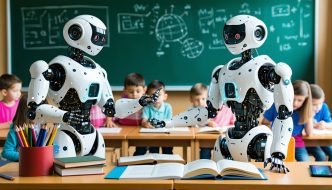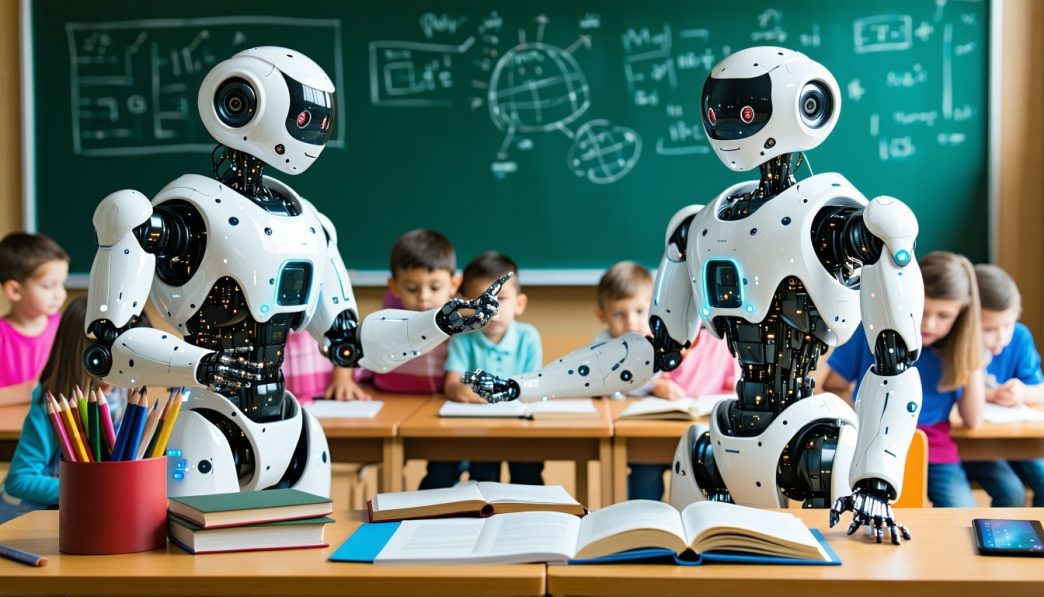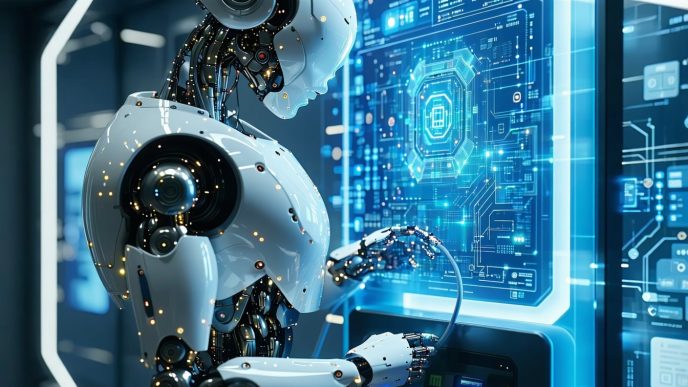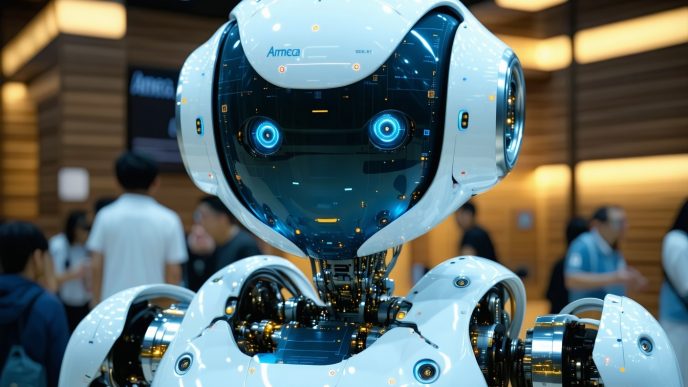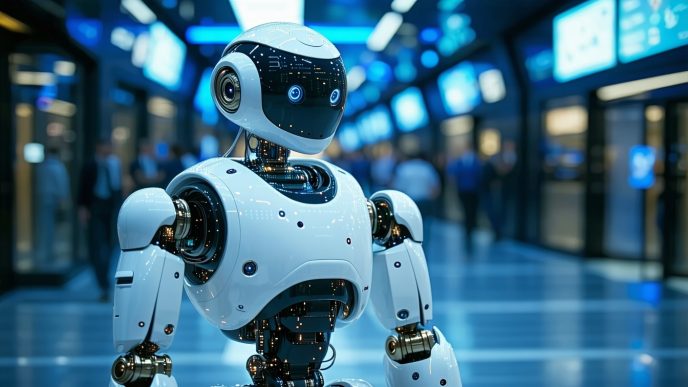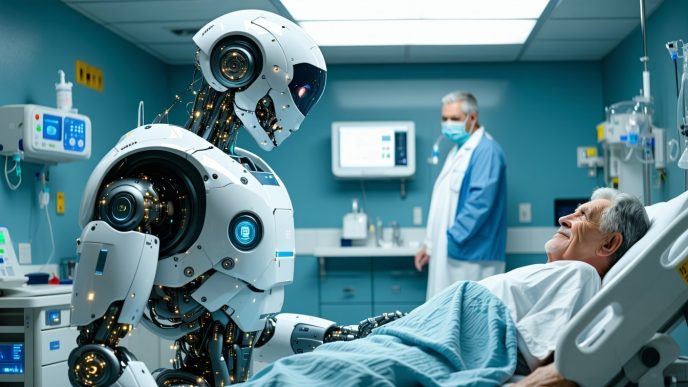Introduction to Humanoid Robots in Education
Humanoid robots have emerged as innovative tools in the field of education, transforming traditional teaching methods. These robots mimic human appearance and behavior, making them relatable and engaging for students.
The Role of Humanoid Robots in Teaching
Humanoid robots play a multifaceted role in teaching. They serve not only as educators but also as facilitators of learning. Their interactive capabilities allow for personalized instruction, adapting to the individual learning paces of students.
The presence of a humanoid robot in the classroom can significantly enhance student engagement. By demonstrating complex concepts through physical movements and interactions, these robots create a more dynamic learning environment. Additionally, they can assist in various subjects, including coding, science, technology, engineering, and mathematics (STEM).
Benefits of Using Humanoid Robots for Education
The integration of humanoid robots in education offers numerous benefits:
| Benefit | Description |
|---|---|
| Engagement | Students are often more interested in learning when interactive robots are involved. |
| Adaptability | Robots can adjust their teaching styles to meet individual student needs. |
| Real-World Skills | Learning with robots prepares students for future careers in technology and robotics. |
| Collaboration | Robots can promote teamwork among students as they work together on tasks. |
Through these advantages, humanoid robots for education foster a more hands-on and interactive learning experience. This innovative approach not only boosts cognitive skills but also encourages creativity and critical thinking among students.
As technology continues to evolve, the potential for humanoid robots in educational settings expands, promising a reimagined future for teaching and learning. For more insights into the applications of robotics in the classroom, visit our article on humanoid robots for kids.
Teaching Coding with Humanoid Robots
Humanoid robots have transformed the landscape of education, particularly in teaching coding and STEM (Science, Technology, Engineering, and Mathematics) subjects. Their interactive capabilities foster engagement, making them a compelling tool in the classroom.
Enhancing STEM Education
The integration of humanoid robots into STEM education provides a hands-on learning experience. These robots can simplify complex concepts in programming and robotics, making them more accessible to students. Teachers can demonstrate coding principles and engineering concepts through real-time interaction with the robots. This practical approach aids in cementing theoretical knowledge through application.
| Benefits of Humanoid Robots in STEM Education | Description |
|---|---|
| Engagement | Captures students’ attention and holds interest. |
| Practical Learning | Provides hands-on experience with coding and robotics. |
| Collaboration | Encourages teamwork among students during projects. |
| Problem Solving | Helps develop critical thinking skills through real-world applications. |
Interactive Coding Activities with Humanoid Robots
Interactive coding activities using humanoid robots can further enhance learning. Students can engage in various tasks, such as programming robots to navigate mazes or complete specific actions based on coded commands. This approach encourages creativity and experimentation while teaching foundational coding skills.
Common interactive activities include:
- Obstacle Courses: Students code robots to follow a path or avoid obstacles, fostering spatial awareness and logic.
- Performance Tasks: Students can create sequences of commands to make the robots perform dances or share stories.
- Collaborative Challenges: Groups can compete to see which robot completes a task first, promoting teamwork and problem-solving.
Hands-on learning with humanoid robots results in a dynamic educational environment where students are more likely to grasp coding concepts effectively. For more insights on incorporating humanoid robots in education, visit our articles on humanoid robots for kids and robotics unlimited zeus.
Applications of Humanoid Robots in the Classroom
Humanoid robots are transforming education by offering interactive and engaging applications that enhance learning experiences. By incorporating these robots into the classroom, educators can facilitate hands-on learning and real-world problem-solving opportunities for students.
Hands-On Learning Experiences
Humanoid robots provide students with a chance to engage in practical, hands-on experiences. When students interact with robots, they are often required to collaborate, experiment, and iterate in their learning processes. These activities can include programming tasks, robotics competitions, and team projects that involve building and coding.
Engaging with humanoid robots can improve several core skills, including:
| Skill Developed | Description |
|---|---|
| Problem-Solving | Students learn to troubleshoot issues that arise while programming robots. |
| Critical Thinking | They analyze situations and devise strategies to accomplish tasks effectively. |
| Collaboration | Working in groups to achieve shared objectives fosters teamwork and communication. |
| Creativity | Designing unique robot behaviors and functionalities encourages innovative thinking. |
Real-World Problem Solving
Humanoid robots can simulate real-world scenarios that require students to apply their knowledge to solve practical challenges. This method of learning encourages students to think critically and innovate solutions to problems they may encounter outside the classroom environment.
Examples include:
- STEM Projects: Students can work on projects that tackle environmental issues, such as creating robots that can sort recyclable materials.
- Medical Training: Robots can be programmed to simulate patient interactions, providing an avenue for medical students to practice communication and diagnosis skills.
- Disaster Response: Students can program robots to navigate obstacles and perform specific tasks, such as delivering supplies in a simulated disaster scenario.
Through these applications of humanoid robots, students not only learn coding and robotics but also gain insights into industry practices, preparing them for future careers. To find out about different humanoid robots that support educational endeavors, explore our article on humanoid robots for education.
Programming Humanoid Robots
The integration of humanoid robots in educational settings has led to innovative methods of teaching coding and programming concepts. This section examines the coding languages suitable for humanoid robots and various programming techniques tailored for educational purposes.
Coding Languages for Humanoid Robots
Humanoid robots can be programmed using several coding languages, each offering distinct features and benefits. Below is a table outlining common programming languages used with humanoid robots, along with their primary characteristics.
| Language | Description | Suitable For |
|---|---|---|
| Python | A versatile language known for its readability. | Beginners, scripting |
| C++ | Offers control over hardware and performance. | Advanced programming and robotics |
| Java | Object-oriented language with platform independence. | Interactive applications |
| Scratch | Visual programming language ideal for beginners. | Children and introductory coding |
Python is particularly popular due to its simplicity, making it accessible for students who are new to programming. Scratch utilizes a visual interface, allowing young learners to grasp coding concepts easily. More advanced learners might explore C++ or Java for more complex programming tasks.
Programming Techniques for Educational Purposes
In teaching coding through humanoid robots, several techniques can enhance comprehension and engagement. Implementing hands-on learning, challenges, and collaborative projects can foster a deeper understanding of programming.
| Technique | Description | Benefits |
|---|---|---|
| Interactive Coding | Engaging students with real-time feedback. | Enhances problem-solving skills |
| Group Projects | Collaborating on programming tasks. | Promotes teamwork and communication |
| Gamification | Introducing game-like elements to coding tasks. | Increases motivation and participation |
Interactive coding allows students to see immediate outcomes from their programming, reinforcing concepts through practice. Group projects encourage collaboration, teaching important social skills alongside coding abilities. Gamification introduces an enjoyable aspect that can make learning coding more appealing.
Utilizing these coding languages and techniques can significantly enhance the effectiveness of humanoid robots for education, making complex programming tasks approachable and enjoyable for students. For further insights into utilizing humanoid robots within educational frameworks, explore other areas of application in our articles on humanoid robots for education.
Humanoid Robots for STEM Subjects
Humanoid robots play a significant role in enhancing education across STEM (Science, Technology, Engineering, Mathematics) subjects. Their interactive nature makes them ideal tools for engaging students in various educational activities.
Incorporating Robotics in Science Classes
In science classes, humanoid robots can facilitate experiential learning. They can be programmed to demonstrate scientific principles through experiments, making abstract concepts more tangible. For instance, using a robot to simulate the effects of gravity can help students understand this fundamental principle more effectively.
| Science Concept | Robot Application |
|---|---|
| Gravity | Simulate falling objects |
| Circulatory System | Visualize blood flow |
| Ecology | Model ecosystems interactions |
Students can design experiments to observe how robots respond to different stimuli, fostering a hands-on understanding of scientific inquiry. This engagement encourages critical thinking and problem-solving skills.
Using Robots for Math and Engineering Exercises
Incorporating humanoid robots in math and engineering exercises promotes interactive learning and real-world applications of math concepts. Robots can help students understand complex mathematical problems through visual representation and engaging methods.
| Math Concept | Robot Application |
|---|---|
| Geometry | Navigate through obstacle courses |
| Algebra | Solve equations using robotic movements |
| Measurement | Calculate distances and angles |
For engineering, students can work on programming robots to perform specific tasks or follow precise instructions, enhancing their understanding of engineering principles. This practical experience not only solidifies theoretical knowledge but also builds collaboration skills when students work in groups on projects.
The integration of humanoid robots in both science and math curricula creates a dynamic learning environment, harnessing technology to enrich education. Students become more engaged and motivated participants in their educational journey, which aligns with current trends in humanoid robots for education.
Engaging Students with Humanoid Robots
Humanoid robots in educational settings create unique opportunities for engagement and interaction among students. Utilizing these robots fosters creativity, innovation, and collaborative learning, which enhances the overall educational experience.
Fostering Creativity and Innovation
Incorporating humanoid robots into the classroom encourages students to think outside the box. The ability to program and interact with these robots allows students to express their creativity through various coding projects and challenges. Students can design their own programs or even create new functionalities for the robots, which can lead to innovative problem-solving approaches.
A study on student engagement showed that hands-on activities involving humanoid robots resulted in a significant increase in creative thinking skills. The following table illustrates the effects of robot integration on student creativity, as reported by educators:
| Aspect of Creativity | Before Humanoid Robots | After Humanoid Robots |
|---|---|---|
| Problem Solving | 60% | 80% |
| Creativity in Design | 55% | 75% |
| Collaboration | 50% | 85% |
These results indicate that humanoid robots can serve as powerful tools for enhancing students’ creativity in educational settings.
Encouraging Collaborative Learning
Humanoid robots also promote teamwork and collaborative learning among students. By working together to program and troubleshoot issues with robots, students develop essential social skills and a sense of community. Group projects involving humanoid robots allow students to share ideas, assign roles, and communicate effectively, enhancing their collaborative abilities.
Educators can implement team-based challenges where groups compete to complete tasks using humanoid robots. This not only encourages teamwork but also makes learning fun and engaging. The table below provides some examples of collaborative activities utilizing humanoid robots:
| Collaborative Activity | Learning Objective |
|---|---|
| Robot Race | Team strategy and coordination |
| Group Programming Challenge | Problem-solving and creativity |
| Collaborative Robot Showcase | Presentation and teamwork |
By integrating humanoid robots into learning experiences, students are more likely to engage actively and work together towards common goals. As they develop these essential skills, they are better prepared for future academic and professional challenges. For more insights into the role of humanoid robots in education, visit our article on humanoid robots for education.
Challenges and Considerations
As humanoid robots become increasingly integrated into education, several challenges and considerations emerge that need to be addressed to ensure their successful implementation and use.
Technical Challenges in Implementing Humanoid Robots
The deployment of humanoid robots in educational settings presents various technical challenges. These include:
-
Complexity of Design: Designing humanoid robots involves intricate engineering and software development. It requires expertise in robotics, programming, and artificial intelligence.
-
Maintenance and Support: Regular maintenance is necessary for humanoid robots to function effectively. Schools may need dedicated personnel for troubleshooting and repairs, potentially adding to operational costs.
-
Integration with Existing Curriculum: Incorporating humanoid robots into established teaching frameworks can be difficult. Educators may require training to effectively use these robots in lessons.
| Challenge | Description |
|---|---|
| Complexity of Design | Requires advanced engineering and programming skills. |
| Maintenance and Support | Needs regular upkeep and troubleshooting resources. |
| Integration with Existing Curriculum | Challenges in aligning robots with teaching standards. |
Technical solutions are evolving, ensuring a smoother introduction of humanoid robots in learning environments. Collaboration between educators and tech developers can facilitate the creation of user-friendly platforms that enhance the teaching experience.
Ethical and Social Implications
The use of humanoid robots in education raises several ethical and social considerations that must be navigated with care:
-
Data Privacy: Humanoid robots often gather data on students’ interactions and performance. Protecting this data is crucial to maintain student privacy and comply with regulations.
-
Dependency on Technology: Over-reliance on humanoid robots for teaching could hinder students’ development of critical thinking and problem-solving skills. Balance between human instruction and robotic assistance is essential.
-
Social Development: Introducing robots in the classroom may alter social dynamics among students. Educators must ensure that interaction with robots does not replace essential peer-to-peer engagement.
| Ethical Issue | Description |
|---|---|
| Data Privacy | Essential to safeguard student data collected by robots. |
| Dependency on Technology | Important to maintain balance with traditional teaching methods. |
| Social Development | Needs consideration of interactions in the learning environment. |
Addressing these ethical and social implications requires ongoing dialogue among educators, students, and parents to foster a prudent approach toward integrating humanoid robots into educational settings. Awareness and proactive measures can mitigate potential negative impacts while enhancing the benefits of robotics in learning.
For more insights on how humanoid robots might reshape educational landscapes, explore articles on humanoid robots for education and robot emotions and ethics.
Future of Education with Humanoid Robots
Humanoid robots are set to transform educational environments in numerous ways. Their integration into classrooms carries the potential to enhance learning experiences and adapt to the diverse needs of students.
Potential Impact of Humanoid Robots on Education
The inclusion of humanoid robots in educational settings could lead to numerous benefits, such as personalized learning, improved engagement, and the facilitation of complex concepts. These robots can provide one-on-one assistance to students, tailoring lessons to fit individual learning styles and paces.
| Impact Area | Potential Benefit |
|---|---|
| Personalized Learning | Adapts lessons based on student performance |
| Engagement | Increases interest through interactive lessons |
| Concept Visualization | Helps visualize abstract concepts in STEM education |
| Accessibility | Provides support for students with learning disabilities |
Additionally, the use of humanoid robots can help bridge the gap between theoretical knowledge and practical implementation, making learning more relevant for students.
Evolving Role of Robotics in Learning
As technology advances, the role of robotics in education will continue to evolve. Humanoid robots are likely to become multifunctional tools that not only teach coding and STEM subjects but also support social skills and emotional learning.
They can serve as platforms for collaborative projects, encouraging teamwork and communication among students. Moreover, integrating robots into the curriculum can increase students’ familiarity with technology, preparing them for future careers in a rapidly advancing job market.
Humanoid robots also have the potential to promote inclusivity within educational institutions. They can assist in language learning, making it easier for non-native speakers to practice and improve their language skills. Resources such as humanoid robots for kids can further enhance the role of these machines in creating an inclusive atmosphere.
The future of education includes a growing integration of humanoid robots, offering endless possibilities for enhancing learning experiences. As they adapt to the changing educational landscape, these robots will become essential tools in fostering a love for learning and encouraging critical thinking skills among students.
